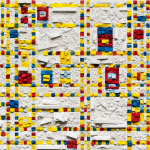
Vik Muniz Brazilian, b. 1961
Metachrome (Broadway Boogie Woogie, after Piet Mondrian), 2016
Archival pigment print
101.6 x 106 cm. (40 x 41 3/4 in.)
Edition of 6 + 4 AP
Copyright The Artist
Further images
Vik Muniz’s Metachrome series, initiated in 2016, constitutes a playful yet incisive re-examination of canonical nineteenth- and twentieth-century artworks. Drawing upon the visual languages of artists such as Yves Klein,...
Vik Muniz’s Metachrome series, initiated in 2016, constitutes a playful yet incisive re-examination of canonical nineteenth- and twentieth-century artworks. Drawing upon the visual languages of artists such as Yves Klein, Mark Rothko and Piet Mondrian, Muniz recreates these familiar works using fragments of pastel crayons and coloured pigments, arranging them into intricate, collage-like assemblages that are then photographed to form the final work. In doing so, he invites the viewer to “re-see” and reconsider these celebrated images – not merely as aesthetic objects, but as reflections on the very processes of artistic creation. In the present example, Muniz reconstructs Mondrian's Broadway Boogie Woogie, which now resides in the Museum of Modern Art (MoMA), New York.
The title Metachrome alludes conceptually to Bertolt Brecht’s notion of metatheatre: a form that deliberately disrupts theatrical illusion to reveal the mechanics of performance. Similarly, Muniz’s works expose the constructed nature of pictorial representation by foregrounding their own materiality. The pastel crayons – the tools of production – remain visibly present within the photographic image, their physicality suspended in translation from object to photograph. These remnants, deliberately included as integral components rather than incidental traces, transform the image into a layered record of artistic labour. The crayons thus function as both evidence and embodiment of process, simultaneously asserting and undermining the illusion of painterly surface.
This concern with material and method recalls Muniz’s earlier Pictures of Pigment series, in which he substituted traditional paint with pure pigment, foregrounding colour as both form and substance. In Metachrome, Muniz extends this exploration further, heightening the tactile immediacy and chromatic intensity of pastel. The resulting compositions evoke the meticulous precision of mosaics, their densely textured surfaces serving as a visceral reminder of the artist’s hand. The interplay of texture and hue draws attention to the elemental foundations of painting – colour, form, and surface – while the act of photographic translation adds a further layer of mediation and reflection.
By reimagining canonical works through such an unorthodox lens, Muniz simultaneously honours and unsettles the traditions of art history. Metachrome does not simply replicate or reinterpret its sources; it interrogates the nature of representation itself, blurring the boundaries between artwork and medium, object and image.
Through this series, Muniz dismantles the illusionism central to painting and replaces it with a material and conceptual narrative grounded in the realities of artistic production. Metachrome thus stands as both a celebration of colour and form and a meditation on the act of making, prompting the viewer to approach the familiar anew, with renewed awareness of the tactile and conceptual dimensions of art.
The title Metachrome alludes conceptually to Bertolt Brecht’s notion of metatheatre: a form that deliberately disrupts theatrical illusion to reveal the mechanics of performance. Similarly, Muniz’s works expose the constructed nature of pictorial representation by foregrounding their own materiality. The pastel crayons – the tools of production – remain visibly present within the photographic image, their physicality suspended in translation from object to photograph. These remnants, deliberately included as integral components rather than incidental traces, transform the image into a layered record of artistic labour. The crayons thus function as both evidence and embodiment of process, simultaneously asserting and undermining the illusion of painterly surface.
This concern with material and method recalls Muniz’s earlier Pictures of Pigment series, in which he substituted traditional paint with pure pigment, foregrounding colour as both form and substance. In Metachrome, Muniz extends this exploration further, heightening the tactile immediacy and chromatic intensity of pastel. The resulting compositions evoke the meticulous precision of mosaics, their densely textured surfaces serving as a visceral reminder of the artist’s hand. The interplay of texture and hue draws attention to the elemental foundations of painting – colour, form, and surface – while the act of photographic translation adds a further layer of mediation and reflection.
By reimagining canonical works through such an unorthodox lens, Muniz simultaneously honours and unsettles the traditions of art history. Metachrome does not simply replicate or reinterpret its sources; it interrogates the nature of representation itself, blurring the boundaries between artwork and medium, object and image.
Through this series, Muniz dismantles the illusionism central to painting and replaces it with a material and conceptual narrative grounded in the realities of artistic production. Metachrome thus stands as both a celebration of colour and form and a meditation on the act of making, prompting the viewer to approach the familiar anew, with renewed awareness of the tactile and conceptual dimensions of art.
